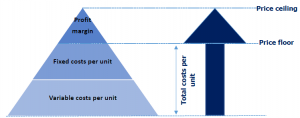Fall is already here and winter is closer than expected. As business starts to slow take the opportunity to reflect on what was great, good, or not-so-good during this growing season. This time of year also brings the opportunity to start planning next year’s strategies. Pricing strategy is one of the key strategies influencing your earnings. This article provides you the top 5 issues you should consider before setting prices for your products.
1. Define your price floor.
The price floor is the minimum price you can afford to receive from customers and still cover the total costs involved in bringing your products to life. A tomato farm that sells tomatoes by pounds can calculate the price floor, or total costs per pound of tomato, by adding all costs and dividing them by the total pounds produced. Costs can be further categorized as variable costs if they vary with the level of production (seed, water, fertilizer) or fixed costs if they do not vary with production (rents, administrative labor). Good record keeping facilitates price floor calculations. Calculating your costs per unit of product, or price floor, will help you determine the minimum price for your product. Of course you would want to make a profit, so any additional dollars that you receive after covering your price floor will be a profit margin. This is a good way to feel comfortable on setting a price that will earn you some profits. Computing your costs can also help you determine how well your business doing with respect to previous performance.
2. Define your price ceiling.
The price ceiling depends on the maximum price consumers are willing to pay for your product. Figure 1 is an illustration of how costs, profit margin, and prices are related. The set of prices between the price floor and the price ceiling is the range of potential prices that you can set for your product.
How can you estimate your price ceiling? First, you need to assess what is the value that customers perceive from your product. Keep in mind that while you sell product or services, customers perceive benefits and values. One way to estimate the value of your product is by asking customers what are the things they like about your product, does it have a better taste, does it save them time, is it convenient?
Profit margin is calculated by the selling price minus the price floor (see formula below). The product profit margin is ultimately what will keep your business succeeding. You can use that profit margin to grow your business, reinvest, or replace equipment or inventory. Some businesses find it useful to compare profit margins of different products, so they can assess how each product contributes to total farm profitability. Keep in mind that you are unlikely to achieve the same profit margin across all products.
3.Your selling price has a lot to say about the image of your company.
The price that you set for your products reflects their quality. I mentioned above how important it is to understand your customers. Talk to them and find out why they buy from you and what they buy. The point is to assess the image of your company from your customers’ point of view and how can you use that image (or correct it) to set your selling prices. Pricing your products too cheap may get customers wondering what if there is something wrong with your product. On the other hand, if the price is too high they may perceive a better quality or wonder if you are taking advantage.
Sometimes small businesses tend to slash prices so they can increase sales. Avoid falling into the pattern of discount offering, especially if your prices are below your price floor and you are not covering costs. Sometimes it is useful to offer lower introductory prices so you can attract customers to buy a new product. Just keep in mind that introductory prices can help to create a niche market but it may not be a sustainable strategy if you do not increase prices in the future.
4. Identify your competitor’s strategies.
This is a key aspect impacting your pricing strategy. You need to know who your direct competitors are and the range of products they offer. Investigate how are your competitors’ products compare to yours, their prices, and their market strategies. Your goal is to offer products and services that provide more benefits to your customers than the competition. However, you want to avoid getting into a price war as much as possible. Price wars are created when you and your competitors cut down prices to gain market share. This strategy can be dangerous for small businesses as it can undermine your sense of worth and the value of your business. A better alternative is to win the non-price competition battle by differentiating your product.
5. Provide value-based pricing strategy
Price is the monetary value of a product or service. Value-based pricing uses a customer-centric approach to pricing. The higher the value perceived by customers, the higher the price that customers will be willing to pay for it. Thus, it is important to understand the attributes that your customers value, and offer them exactly that. A high value product offers several benefits to customers such as convenience, taste, and freshness. The goal is to build long-term relationships with customers by offering more value than your competitors. Adopting a differentiation strategy can help small businesses gain customer loyalty. Differentiation means offering products and services that are important to customers.
